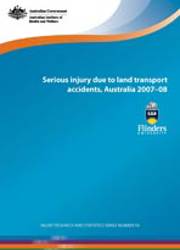Summary
This report presents information on serious injury, that is, injury resulting in hospitalisation but not in-hospital death, due to land transport accidents in 2007–08. There is a focus on road vehicle traffic crashes which accounted for nearly two-thirds of all serious injury. This is a companion report to the reports on serious injury due to land transport accidents in Australia for the 2008–09 financial year and on the trends in serious injury due to land transport accidents in Australia 2000–01 to 2008–09.
Land transport accidents
Land transport accidents accounted for 0.7% of all hospitalisations and 10.9% of all hospitalisations due to injury in Australia during 2007–08. There were 51,710 persons seriously injured due to land transport injury, resulting in 224,171 patient days in hospital and a mean length of stay of 4.3 days.
Of those seriously injured, 62.9% (n = 32,543) were due to traffic (on-road) accidents, while 26.9% (n = 13,900) were due to non-traffic (off-road) accidents. For 10.2% (n = 5,267) of serious injury cases, the location was not specified.
Males were 2.3 times more likely than females to be seriously injured as a result of a land transport accident, while just over 50% of those seriously injured were aged less than 30 years.
Nationally, and in each jurisdiction, the age-specific rates of serious injury due to land transport accidents were highest at ages 15–24 years.
When looking at mode of transport, car occupants accounted for 34.3% (n = 17,749) of all serious injury cases, followed by motorcyclists (27.2%, n = 14,084) and pedal cyclists (17.6%, n = 9,102).
Road vehicle traffic crashes
For traffic (on-road) accidents, 48.5% of those seriously injured were car occupants, 23.1% were motorcyclists and 14.8% were pedal cyclists. For those seriously injured due to traffic (on-road) accidents, 25.8% were judged to be suffering from injuries which were considered to be high threat to life.
When looking at injury rates in relation to the number of registered vehicles, motorcyclists had by far the highest rate of 1,330 serious injury cases per 100,000 registered vehicles. This was almost ten times the corresponding rate for car occupants.
The Northern Territory had by far the highest rates of serious injury per 100,000 vehicle type for cars, motorcycles and pick-up trucks or vans. Conversely, the Northern Territory had by far the lowest rate of serious injury for buses. The Northern Territory also had easily the highest age-standardised rates of serious injury and serious injury with high threat to life for road vehicle traffic accidents.
Age-standardised rates of serious injury increased according to remoteness of the person’s usual residence from an urban centre. For persons with serious injuries that posed a high threat to life, the mean length of stay in hospital (11.4 days) was more than double that of seriously injured persons and was greater across all age groups.



